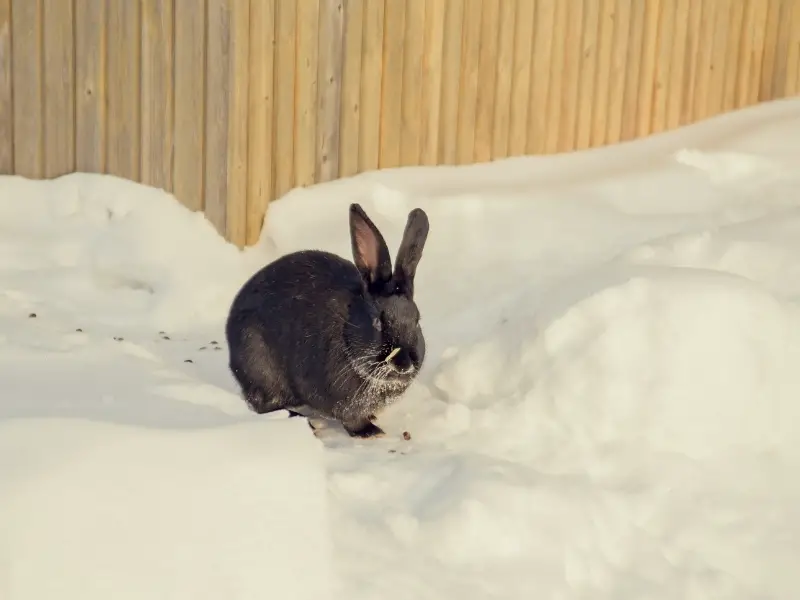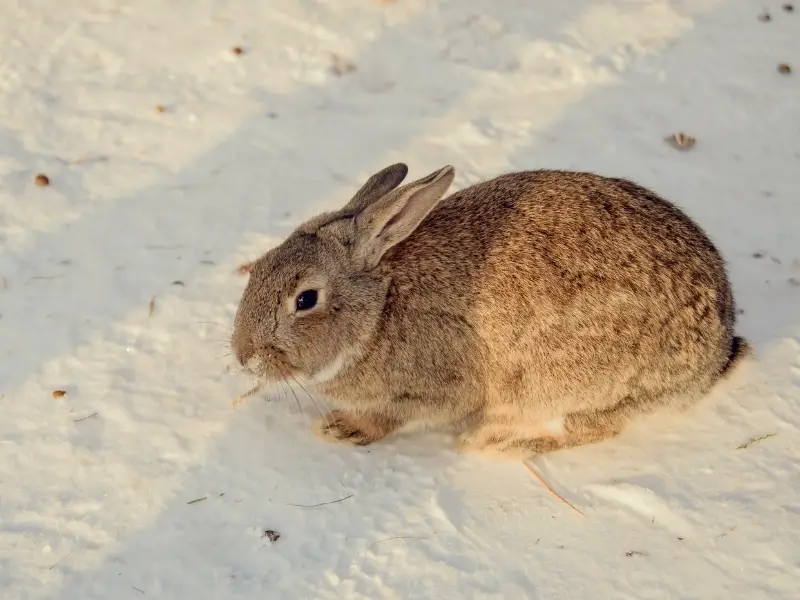Most pet rabbit breeds seem to be well equipped for winter. These bunnies have thick pads under their feet and warm fur coats to help them survive when the weather turns cold. But is this enough?
What if it gets really cold? Is your rabbit safe from the cold?
Rabbits can tolerate the cold pretty well. If they are kept dry and out of the wind, bunnies should be ok for a temperature getting as low as 15 ℉. However, if the temperature drops even further, you need to check for signs of your rabbit being cold and take steps to ensure your bunny is comfortable.
What are the signs you need to watch out for when your bunny gets cold? And how can you remedy the situation?
How Cold Is Too Cold for Rabbits?
The ideal internal body temperature range for a rabbit is between 101-103 ℉. These fluffy mammals are comfortable when the range of temperature is between 40-75 ℉; however, it is best if temperatures are comfortable 50-70 ℉.
Should the temperatures drop to 15 ℉ or lower, your bunny may still be ok, provided there isn’t wind and your Ms. Fluffles is dry. If your bunny gets wet in the cold, it could lead to hypothermia and it could die like a rabbit’s coat takes a long time to dry.
If you aren’t sure if your bunny is too cold, you can always take their temperature. If it is under 100 ℉, then you know it is time to help your fluffy-eared bestie warm up. However, you can also lookout for signs that will tell you that your bunny is cold…
How Do I Know If My Rabbit Is Cold?
You surely want to prevent your bunny from being cold, so step 1 is knowing what signs to look out for that indicate Mr. Fluffles is cold.
Sign 1: The Ears
One of the first signs your bunny is cold is feeling its ears. Since a rabbit expels heat through its ears (it is how they regulate its body temperature), cool ears simply mean that your bunny doesn’t have extra heat to lose.
However, this isn’t the most accurate way to tell your rabbit is cold.
Sign 2: Low on Energy
In general, when it gets colder, you’ll find that your fluffy bestie has a lot more energy, moving around and also wanting to play more, than during the summer months.
If the temperature is too cold and Ms. Fluffles gets cold, then your rabbit may be low on energy and they may become lethargic, sitting still for longer periods of time.
Sign 3: The Bunny Loaf
When a rabbit is cold, it may be doing the bunny loaf to conserve energy. The bunny loaf, also called bunny bread or bun loaf, is when your rabbit tucks its legs in, relaxes its ears, and droops its head to help limit how much of its body surface is exposed. Thus, your bunny helps itself retain more heat.
So if you see your rabbit in this position, it is trying to keep warm because it feels cold.
How to Prepare Your Rabbit for Winter

There are various ways in which you can prepare your rabbit for winter to ensure Mr. Fluffles stays warm and cozy.
Tip 1: If It Gets Too Cold, Bring Your Rabbit Inside
If your rabbit stays outside in a hutch, the best thing you can do if the weather gets really cold (12 ℉ or below, or you see signs that your bunny is cold) is moving your rabbit inside.
Preparation First
But before you just bring your rabbit inside, you need to prepare your bunny. It has been used to living outside and the temperatures there. Rabbits also don’t do well if there is a sudden change in temperate – your home is surely going to be much warmer in winter than 12 ℉.
Thus, it is best to move your rabbit indoors during fall when the temperature inside your home and outside is more similar.
Your other option, should it be quite cold already in fall, is to move your rabbit hutch to your covered porch or garage first, where it is warmer than outside but cooler than in the house. Once Ms. Fluffles has acclimated, you can move her inside the house.
Being Inside
You don’t need to keep your rabbit in a room that is heated all day long. Bunnies love colder temperatures, so any place that’s a comfortable 40 ℉ and up should work.
Bunny-Proofing
If your bunny only stays inside during the cold months, remember to bunny-proof your home. This means ensuring all the spaces they are allowed to explore are safe.
Tip 2: If It’s Not Too Cold, Get the Hutch Ready for Winter
If your winters are mild or cold but not to the extreme, then you can winter-proof your bunny’s hutch that’s outside. To get the hutch winter-proof:
- Ensure there’s no cracks in the walls; you want to keep the wind out
- Raise the hutch so it’s off the ground; this keeps frost and ground cold out too
- Insulate the walls with thick blankets and cardboard
- Add more bedding so your bunny can snuggle up for extra warmth
- Place a microwavable heated pad or warm water bottle in the hutch
- Place a waterproof tarp over the hutch so your bunny doesn’t get wet
- If possible, you can also place a ceramic, no light-emitting heat lamp in the hutch
Tip 3: Give Your Rabbit Enough Food and Water
When your rabbit prepares for the winter months, it naturally tends to eat more so its body can store more fat. Regularly check on your bunny and ensure it has a fresh, day-long supply of hay, and also feed your rabbit more.
While your rabbit always needs fresh drinking water, it is important to check on this as it gets colder. Ensure the water isn’t frozen, and if you are worried about the drinking water freezing because it is so cold, place the water bowl close to the heating pad or heat lamp.
Tip 4: Look After the Baby Rabbits
Kittens, or baby rabbits, should be looked after even more if they are born when it is cold. Anything below 70 ℉ is too cold for these little ones, so it’s best to ensure the doe (mommy rabbit) and her kittens stay inside in a room that’s temperature-controlled.
What Temperature Can Rabbits Live Outside In?
If the outside temperature reaches near-freezing conditions, your rabbit will be fine. Your long-eared fluffy pal just needs a well-insulated hutch to keep it warm and dry.
Conclusion
Knowing what temperatures your rabbit tolerates best is one of the many steps to pet rabbit ownership and looking after your bestie. If it gets too cold during fall and/or winter, then either ensure the hutch is winter-proofed and regularly check on the bunny to ensure it isn’t cold, or bring your rabbit inside.
If you are worried about the summer months and your rabbit being too hot, then you can check out our article on this and what to do!
Related Articles:

